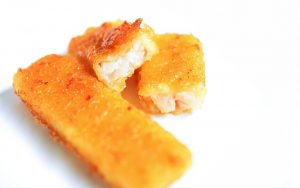Some ways of catching fish are more environmentally-friendly than others:
Supporting Sustainability: A Guide To Responsible Fishing Methods | greenne.com
Unsustainable fishing methods – Wikipedia
… but it’s what happens to the fish when it’s processed that can be the problem…
.
New research makes it clear that fish fingers are not quite the innocent food they seem, as covered in the trade press:
Fish Sticks are Not So Environmentally Friendly, Study Finds | modernfarmer.com
.
Here’s the piece of research from the University of California:
Climate forcing by battered-and-breaded fillets and crab-flavored sticks from Alaska pollock | elementascience.com
.
And here’s the Daily Mail’s very full coverage – which shows how complicated it is to measure the impacts of the fishing industry:
.
 Are fish sticks BAD for the environment? Study finds process to transform Alaskan pollack into other seafood releases TWICE as much greenhouse gas as fishing
Are fish sticks BAD for the environment? Study finds process to transform Alaskan pollack into other seafood releases TWICE as much greenhouse gas as fishing
Fish sticks may seem harmless, but the tiny food is creating a huge carbon footprint.
A new study has found that transforming Alaskan Pollock into fish sticks, imitation crab and fish fillets generates nearly twice the greenhouse gas emissions produced by fishing itself. The team noted that catching the fish is a ‘relatively fuel-efficient fishery’, but then it is shipped in massive containers which burn poor-quality bunker fuel that produces high levels of sulfur particles.
The study, conducted by a team at the University of California – Santa Cruz (UCSC), analysed the largely overlooked process of making certain seafood.
Brandi McKuin, a postdoctoral researcher in environmental studies at UCSC, said: ‘The food system is a significant source of global greenhouse gas emissions, and Alaskan pollock is one of the biggest fisheries in the world.’
Alaskan Pollock is a huge market, as it is processed into different food including fish sticks, imitation crab and fillets.
The fishing of this creature is relatively environmentally friendly, as large nets can capture a massive amount of fish in one haul.
However, the process afterwards is what contributes to climate change. The catch is loaded into large shipping containers that burn a massive amount of fuel, most of which is cheap, poor quality bunker fuel that produces high levels of sulfer particles. And McKuin explains sulfur oxides from ship fuels have a climate-cooling effect.
‘Seafood products that are exported have a lower climate impact than domestic seafood products,’ she said, adding that the climate impacts of shipping will change this year as new regulations for cleaner marine fuels take effect. Shipping has a massive influence on climate and a shift to cleaner fuels will diminish the cooling effect from sulfur oxides and increase the climate impact of products that undergo transoceanic shipping, including seafood.’
Coauthor Elliot Campbell, a professor of environmental studies at UCSC, is a pioneer of data-driven methods of assessing the climate impact of food production. ‘This study highlights the need to expand our view to encompass the entire supply chain,’ he said. ‘It’s not enough to look just at fishing. The picture is much bigger, and it’s much more complicated.’
…
Are fish sticks BAD for the environment? | dailymail.co.uk
Fish Fingers Baked Sticks – Free photo on Pixabay
x